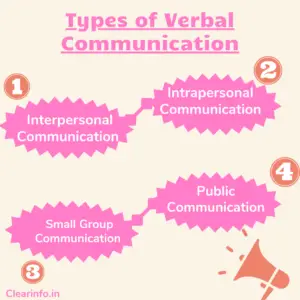Presenting 11 advantages and disadvantages of verbal communication with examples, types, forms & verbal skills. In addition to the importance of verbal communication in the workplace.
What is Verbal Communication?
Verbal communication in business refers to communication that uses language to transmit a message or information. Language could be spoken, written, or use signals and gestures. Formal organizations often use verbal communication for efficiency in presentations, phone calls, meetings, etc.
The different components of such communication include body language, tone, visuals, word choice, and eye behavior. All these components help make a message highly comprehensive for the receiver.
11 Advantages & Disadvantages of Verbal Communication
One should know about the various pros and cons of verbal communication for organizations to use it best.
Advantages of verbal communication:
1. Time-saving: One of the biggest advantages of using verbal communication in organizations is that it facilitates immediate transmission of messages or information, therefore the person on the receiving end does not have to wait for the message to get delivered through a selected medium hence saving a lot of time.
2. Instant feedback: The positive aspects of verbal communication include the facility of instant feedback which is often not possible in written communication. Quick feedback in conversation also completes the loop of the communication cycle between the sender and the receiver.
3. Convenience: Verbal communication makes it easier to share a message or information with better clarity and expression, hence promoting better understanding among the receivers.
4. No delays: Another merit of verbal communication is that it facilitates an instant exchange of thoughts and ideas in case of emergencies and helps avoid any kind of delay in decision-making.
5. Personal touch: Since verbal communication uses tone, pitch, and facial expressions, it adds a human and personal touch to messages. This ultimately helps reflect a friendly and warm spirit in messages rather than a domineering tone.
6. Financially efficient: Verbal communication is one of the most financially efficient modes of communication in formal businesses as it does not necessarily require paperwork or other formalities.
7. Offers motivation: One of the most important benefits of verbal communication is that it motivates employees to participate and encourages them at a personal level to take part in various business communications.
8. Higher confidentiality: Since messages or information are transmitted mostly through personal contact in verbal communication, it becomes easier to maintain the confidentiality of a message by the sender.
9. Support of multiple mediums: Verbal communication always facilitates the sender with the liberty to use various other forms of communication to deliver a message. These forms could be visuals, audio, written messages, presentations, and more.
10. Open to changes: Verbal communication is often open to any kind of changes in terms of decisions or in accordance with any previous communications in an organization. This further helps in eliminating any kind of confusion and misunderstanding among the employees.
11. Quick delegation of responsibilities: Verbal communication makes it possible to delegate authority or responsibility among employees in an organization without wasting time on formalities like paperwork. Employees can revert instantly if they have any questions to ask through the verbal medium.
Disadvantages of verbal communication:
1. Chances of misunderstanding: Since verbal communication is not entirely organized, it may distort a message due to external noise- one of the major elements of communication and create misunderstandings.
2. Inefficient for lengthy messages: One of the biggest demerits of verbal communication is that it may not be fruitful to transmit important or lengthy messages. The sender may fail at explaining or the receiver may not be able to comprehend all at once.
3. Addition of irrelevant information: Since verbal communication has a little spontaneity, it becomes easy for any irrelevant information to slide in and the main topic may lose its importance. This often leads to further delays in successful communication.
4. Risk of denial: One of the most important disadvantages of verbal communication is that the sender or receiver may deny the transmission of a message or information in the future. This risk is present if verbal or oral communication has not been recorded.
5. Unsuitable in long-distance: Because of the elements that verbal communication uses, it may be unsuitable when the distance is more between two people. This may also lead to the lack of one or more principles of effective communication.
6. No previous record: One of the various limitations of verbal communication is that it is often not recorded and hence, can’t be referred to or used as proof in the future. This can create critical issues while resolving conflicts between two identities.
7. Lesser authenticity: Verbal communication often lacks authenticity as it has a personal and informal touch to it. This makes it less suitable for a formal organization where messages need to be authentic and genuine.
8. Easy to forget: Since verbal communication lacks a record, it can be easily forgotten by the receiver. This may further lead to many problems and delays in a formal business operation.
9. Requirement of appropriate skills: Communication is a two-way road and hence, appropriate speaking and listening skills are required at both ends for successful verbal communication.
10. Decreased formality in relations: Verbal communication may sometimes decrease formality in organizational relations and eventually lead to employees not taking their superiors seriously.
11. Time-wasting: Verbal communication easily becomes time-wasting when the people involved in the process are driven away by unnecessary talks. This may lead to an unfruitful communication process as well.
Example of verbal communication
Types of Verbal Communication

1. Interpersonal Communication: This communication happens between two individuals, mostly face-to-face. It is often informal and shows the behavioral qualities of an individual.
2. Intrapersonal Communication: This communication takes place within an individual involving no other people. It includes self-analysis, thoughts, solo speaking, etc.
3. Small Group Communication: When more than two people interact within themselves through verbal communication, it is called small group communication.
4. Public Communication: This communication involves a person interacting with a large group of people in a gathering. It involves addressing a specific type of public at once.
Forms of Verbal Communication:
Verbal communication is commonly divided into two forms, Oral communication, and Written communication.
Oral communication:
Oral communication refers to messages or information being transmitted through the medium of spoken words. Ideas, opinions, or feelings here, are expressed by talking face-to-face, over a phone call, or through voice notes. One of the biggest benefits of oral communication is that it can be successfully executed through only one medium- sound.
Written communication:
When information or messages are transmitted through written words, it is known as written communication. In a business organization, this form of verbal communication can be done through various modes like letters, memos, notices, emails, etc. One of the biggest merits of written communication is that it always provides a record for messages to refer to in the future- which is not usually possible in the oral form of verbal communication.
What are the Benefits of Verbal Communication in the Workplace?
- Fluency in working: One of the main functions of verbal communication is promoting fluency in operations and helping in smooth coordination among employees at different levels.
- Moral-boosting: Verbal communication at the workplace encourages employees to communicate and participate on a personal level and boosts their morale to work better.
What is the Importance of verbal skills?
- Individual relations: In both formal and informal organization, verbal communication methods and skills play a vital role in helping individuals build personal relations and establish stronger connections.
- Speedy transmission: Verbal communication skills are crucial in a formal organization as they help spread/pass information or messages quickly without any unnecessary delays.
How to Improve Verbal Communication Skills
1. Avoid filler words: When sharing information through verbal communication, filler words like ‘so’, ‘umm’, and ‘like’ should be avoided to bring more clarity and brevity when sending a message.
2. Active listening: When receiving a response as the sender or information as a receiver, one needs to actively listen and comprehend to execute successful verbal communication. Along with listening, observation skills are crucial as well.
3. Focus on the issue: For well-executed verbal communication in an organization, the focus needs to stick to the topic of discussion rather than the personal equation that employees share among themselves.
4. Acknowledge others: It is important to acknowledge others when executing verbal communication. Expressing gratitude, affirming one’s feelings, and providing positive feedback in communication reflect the qualities of kindness and build better relations.
What is Non-verbal Communication?
Non-verbal communication is the process in which no words are used to communicate, that is, wordless messages are transmitted. Messages are sent across through nonverbal elements like facial expressions, clothes, tone and pitch of voice, etc. Non-verbal communication often reflects one’s mood, opinion, or feelings and may be paired with written or spoken communication.
Advantages & Disadvantages of Non-verbal Communication
Advantages of Non-verbal communication:
1) Easy transmission: Since non-verbal communication uses a variety of communication modes like visuals, charts, audio-visual, etc, it makes it easy to transmit any kind of message with more clarity and in detail.
Disadvantages Non-verbal communication:
1) Costly: It takes a lot of time and effort to curate a detailed message or information in non-verbal communication. It also costs financially more to frame a good message as it uses visuals and audio-visual modes.
Must Read: Check out our detailed guide to the advantages and disadvantages of non-verbal communication
Difference between Verbal & Non-verbal Communication
Basis of differentiation | Verbal Communication | Non-verbal Communication |
Medium | Verbal communication can be executed by using a single medium. | Non-verbal communication often uses various mediums at the same time to transmit a message. |
Decoding | It is comparatively easier to decode messages in verbal communication as there are words to understand. | It is more difficult to decode a message in non-verbal communication because various factors of communication need attention, such as body language, facial expressions, and gestures. |
Continuity | Verbal communication takes place in discontinuous parts. Communication ends when one or more people stop participating. | Non-verbal communication is often continuous. Even if one person stops to participate, their non-verbal elements continue to communicate something. Intrapersonal communication in non-verbal form may also take place in some cases. |
Advantages & Disadvantages of Communication
Advantage:
1. Mutual trust: Effective communication in a formal organization builds mutual trust and understanding among employees at all levels. This ultimately promotes a positive work environment.
Disadvantage:
2. Misunderstandings or hurtfulness: Communication, in any form, demands considerable effort from both ends to achieve success. Lack of effort or various barriers can cause misunderstandings among employees and this may even lead to hurting one’s feelings.
Frequently Asked Questions
Q1) What are the advantages of verbal communication?
Ans: The advantages of verbal communication are that it is quicker, affordable, open to changes, and offers higher confidentiality.
Q2) What are the disadvantages of verbal communication?
Ans: The disadvantages of verbal communication are that there are always chances of misunderstandings, and risk of denial, and it is unsuitable for long-distance communication.
Q3) What are the advantages and disadvantages of verbal and non-verbal communication?
Ans: An advantage of verbal communication is that it allows for quick delegation of responsibilities and its disadvantage is that it doesn’t have any record for future reference. An advantage of non-verbal communication is that one can use multiple mediums to communicate. A disadvantage of non-verbal communication is that it may become costly to execute in some cases.



